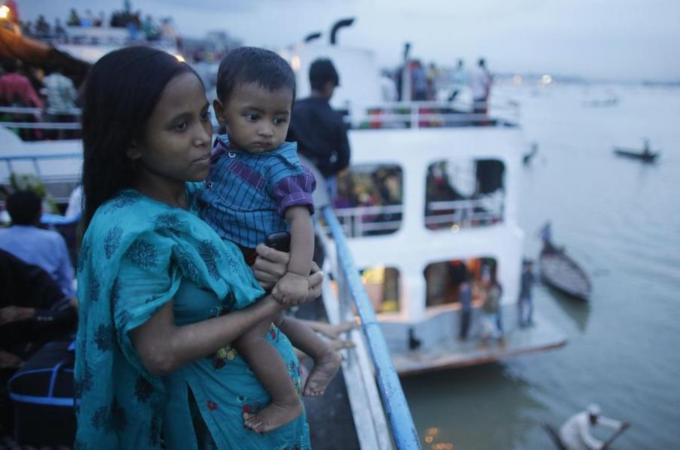Experts try to explain dramatic fall in number of women dying during labour despite widespread poverty.
Dhaka, Bangladesh – Experts are struggling to explain what has been called the “Bangladesh paradox” after the developing nation reached a milestone in the battle to reduce the number of women dying during childbirth, but failing to score well in other development indices.
It has become one of only a handful of countries to achieve one of the United Nations’ key development targets by sharply decreasing its maternal mortality ratio (MMR), the number of mothers who die per 100,000 live births.
Yet the South Asian nation of 160 million people has done so in spite of widespread poverty, regular political upheaval and weak institutions – factors some think may have even contributed to its achievement.
Doctor Zafrullah Chowdhury, the founder of one of Bangladesh’s oldest NGOs, Gonoshasta Kendra (GK), believes a transformation in attitudes towards women may explain this Bangladeshi success story.
“Culture has not changed, religion has not changed – but attitude has changed,” he told Al Jazeera.
Regional leader
According to an article in the Lancet medical journal Bangladesh is on target to become one of only nine countries to reduce its MMR by three quarters by 2015 – one of the UN’s key millennium development goals (MDG).
Bangladesh’s current MMR is about 194 maternal deaths per 100,000 live births, but between 1998-2001 this averaged 322 per year and in the intervening years, notes the Lancet, the country beat all expectations with a decline of 5.6 percent a year.
This means the MMR in Bangladesh has fallen by more than 66 percent over the last two decades – putting it ahead of its richer neighbours: Pakistan’s MMR is 260 and India’s is 230.
Experts are trying to explain the apparent paradox of plummeting MMR in a country that otherwise scores poorly on other development indicators.
Bangladesh’s GDP per capita in 2011 was $752 compared with Pakistan’s $1,256, and out of all South Asia nations, it has the lowest proportions of births attended by a “skilled birth attendant” with only around 30 percent of births supervised, compared with 50 percent in India.
Yet the Lancet said that despite being poorer than Pakistan – a country it split away from in 1971 – Bangladesh is ahead in “all education and health indicators”.
Changing attitudes
Dr Chowdhury attributes this success to changes in attitude after the country’s 1971 independence struggle to separate from Pakistan. He played a key role in forming health services for refugees and wounded soldiers.
“Many of the medical developments came during the war … our war changed our attitude,” he said.
In particular, the conflict forced Bangladeshis to confront harsh realities – hundreds of thousands of women may have been raped by Pakistani troops and their local sympathisers.
Dr Chowdhury recounts being told that he should not bring up family planning with “orthodox” village women – but that in the end he did not have to because they confronted him to demand it.
|
|
| Childbirth risks high in Bangladesh |
Given scarce resources, he had to mobilise and train refugee women and girls to become nurses, providing an important lesson: “For any maternal mortality theme, or any subject you want to take, the key is the women.”
With no health infrastructure and a traditional culture that prevented male health workers from entering rural homes, GK extolled the practice of sending women to villages to promote family planning or educate people about health.
Another indication of the changes that have taken place in Bangladesh is the dramatic fall in the fertility rate in the country.
In 1983, the average Bangladeshi woman had 6.4 children, today this is 2.2 – while Pakistan lags behind at 3.3.
The Lancet notes that family planning and hence lower fertility rates have perhaps had a greater impact on MMR than improved health infrastructure.
Bangladesh has also advanced gender positive development policies – including free education for girls – placing women at the forefront of another huge shift in attitudes in the workplace.
In 1990, at the beginning of the MDG measuring period, the industrialised garments industry was in its infancy employing 400,000 people, but by 2014, the sector employed about 4 million people – up to 80 percent of them women.
For women, spending time outside the home empowers them, leading to lower fertility rates, enabling them to pursue a career, delay having a family, or have fewer children.
Dr Shams El Arifeen, the author of several Lancet reports on the issue, works at the International Centre for Diarrhoeal Disease Research, Bangladesh (ICDDRB) research centre and hospital in Dhaka. He told Al Jazeera that “the social network has changed, the economic conditions have changed, and distances have changed”.
“We are more connected and we are more able to travel,” he said. “If you have a problem, you are able to seek out services.”
He said that Bangladesh’s population density and relatively small size means that even without a huge improvement in services, more women are able to seek the simple professional care they need.
Could do better
But critics say that Bangladesh could have done better on the MMR. But it didn’t because its health infrastructure is weak and it reflects the country’s social hierarchy, with 80 percent of births occurring at home because the poor are often treated with contempt by trained doctors.
There is still a serious dearth of professionalism in the health services in Bangladesh which is described as in “disarray“ by the Lancet. This has resulted in a debate about how to move forward – whether Bangladesh can afford to provide centralised, institutional services to women and families. Or whether alternative routes can be sought out.
Absenteeism at health facilities is also rampant – Dr Arifeen alleges that some patients died at a health facility in the town of Barisal over July’s Eid holiday because all the doctors had simply vacated their posts.
He also did not support the use of traditional birth attendants (TBA), essentially local women who have a social connection to the patient.
“We have reached a point where we have to have a rethink of this philosophy that has so far driven us, which is poor health for poor people,” he said.
“I am of the feeling that we can and should make the jump to deliver the best care that we can to these people. I think TBAs would be a big step back. The West changed because it had trained midwives. Why should this country be any different? Every woman who gets pregnant in this country should have the right to be cared for by the best skilled person that we can provide- and that’s not a TBA.”
However, Samia Arfin, of the research and advocacy NGO, Naripokkho, is wary of the government’s capabilities and said that “the government wanted institutional delivery but our facilities are not ready”.
“[The] monitoring systems aren’t good and there is a lack of accountability from service providers,” Arfin said. “Politicians are not committed and there is so much corruption in the ministry of health, policy is good but implementation is not.”
These issues only heighten the paradox of a country persistently maligned as a “basket case”, becoming a development success story.
Yet, while it is hard to find a scientifically certain explanation for this “Bangladesh paradox”, it seems clear that the praise must go in large part to its women, often striving against adversity.
Source: Aljazeera











